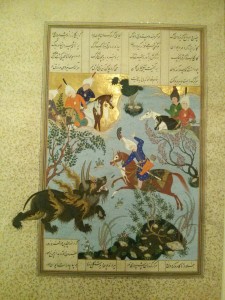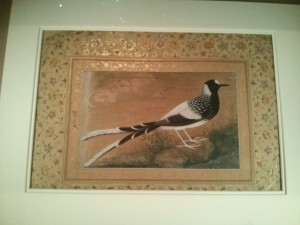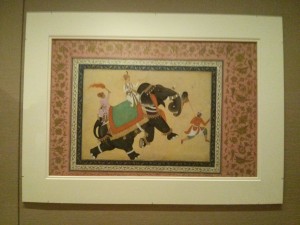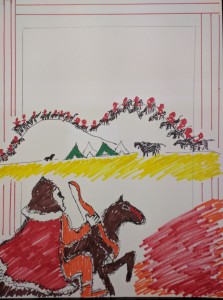Metropolitan Museum: Mongol and Persian Aesthetic Synergy
The late 14th century marked the rise of the Turko-Mongol dynasty with the initial conquest of Samarqand by Tamberlane. Ruling over Iran and Central Asia, much of the rich Persian arts culture was adopted by Tamberlane and his descendants. This intermixing of Mongol rulers adopting many cultural traditions of the Persians they conquered was evident in the museum exhibits during the Metropolitan trip.
I noticed a visual pattern appearing in the paintings from the Iranian art – from the Timurid Dynasty circa mid 1400’s AD to the Safavid Dynasty circa 1500-1600’s AD. For the purpose of this discussion I will group paintings from the Iran region from these periods as “Mongol Influenced Persian Paintings”. What characterizes these Mongol influenced Persian paintings? In contrast from the Mughal period paintings from the Indian Subcontinent which stressed naturalism, still-life, and representing things realistically via objective observation, these Timurid and Safavid illustrations highlighted movement, dynamism. Since the rulers of those periods were the descendants of avid riders and warriors, I like to think of this painting style as the ‘sports photography’ of their day since horses and riding were an integral part of Mongol culture.
Here are some samplings of the Timurid and Safavid period illustrations from our trip to the Metropolitan Art Muesum of New York City. For baseline comparison, I also provide samplings of the Mughal period paintings. Note the dynamism of the subjects, the movements and fast-moving poses of the horse-riders, and the flowing of natural elements almost meld with human subjects. In their form, the paintings’ landscapes and subjects regularly bleed out into the margins of the texts they illustrate. Contrast this with the rather static subjects in the Mughal period, where subject isolation and realism are on display.

Bahram Gur Slays the Rhino-Wolf, Safavid Period, 1530-35, Iran.

Bahram Gur’s Skill with the Bow, Timurid Dynasty 1430, Herat, Afghanistan.

Adam Makes a Pilgrimage, Timurid Period 1425, Iran.

Caesar Captive before Shapur II, Safavid Period 1530-35, Iran.

Spotted Forktail, Mughal Period 1610-16, India.

Prince Riding an Elephant, Mughal Period, 16-17th Century, India.

Tamberlane Invading Samarqand, by Wilson Qin
For my creative piece, I emulate aesthetic forms of this Mongo Influenced Persian period. I raise the question – how might a Persian rebel of the 1400’s time period have represented the Timurid takeover over what is now modern day Iran? Especially since that is a region where the Taziyeh tradition comes from, I illustrated a fantasy version of Tamberlane invading Samarqand, except the city has been replaced by symbolic green and white tents, and the invading army dons red all around – a suggestion to Karbala. In Taziyeh fashion, as the viewer, we take the viewpoint of the Mongol army – as we look in from the bottom left corner of the illustration, we have Tamberlane’s back here even bleeding into the margins, and we can feel his horse is in the position of mid charge fast approaching the attack point. This viewpoint immediately transfers us into the ranks of the horde surrounding the encampment – another nod to the Taziyeh style performance of Husain’s Martyrdom.